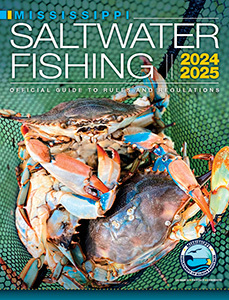Oysters
Oyster Regulations for State-Owned Reefs
Methods of Take
Mississippi’s oyster season for state-owned reefs usually occurs between the colder months of October to April. There are two methods to harvesting oysters: dredging and tonging. An appropriate recreational or commercial oyster harvesting license is required for all methods of harvesting oysters within Mississippi waters.
A dredge may not exceed a weight of 115 pounds. The teeth of a dredge must be 5 inches or less in length and there may not be more than 16 teeth per dredge. A ‘hand’ dredge is smaller in size and has the following specifications: weighs not more than 40 pounds; has 10 or less teeth; a single tooth is not more than 5.25 inches in length. Hand dredges may only be used in harvest areas designated for dredging and are prohibited in tonging areas.
All rules and regulations for harvesting and transportation regarding state-owned oyster reefs and private on-bottom leases can be found in MDMR Regulations; Title 22, Part 1.
Definitions To Know*
Approved Area
A classification used to identify a growing area where harvest for direct marketing is allowed.
Conditionally Approved Area
A classification used to identify a growing area that meets the criteria for the approved classification except under certain conditions described in a management plan. This includes rainfall total and river stages.
Restricted Area
A classification used to identify a growing area where harvesting shall be by special license and the shellstock, following harvest, is subjected to a suitable and effective treatment process through relaying or depuration.
Prohibited Area
A classification used to identify a growing area where the harvest of shellstock for any purpose, except depletion or gathering of seed for aquaculture, is not permitted.
*Definitions from the National Shellfish Sanitation Program’s “Guide for the Control of Molluscan Shellfish.”
State-Owned Oyster Reefs
Oysters may be taken only from those waters approved for shellfish harvest by the MDMR.
The harvesting, shucking, processing and sale of oysters must conform to all regulations specified by state statute and regulations adopted by the MDMR.
Several state-owned reefs are located in approved and conditionally approved waters. They include:
- State-Owned Pass Marianne Reef
- State-Owned Henderson Point Reef
- State-Owned Pass Christian Reef
- State-Owned Biloxi Bay
Following a rainfall, elevated river stage or other pollution event, conditionally approved reefs and affected privately leased areas may be temporarily closed to oystering when poor water quality conditions exist. Such closures are released to local newspapers, television and radio media. Pertinent information about the opening and closing of state-owned reefs is available by visiting the MDMR website at dmr.ms.gov. The information may be updated daily during oyster season.
Special Provisions
Oysters taken from Mississippi waters must be tagged. Each tag must be completed with the license/identification number, harvest date, harvest area and the shell-stock dealer’s name and identification number if the oysters are to be sold. Tags must be affixed to the sacks.
Oysters taken from private on-bottom leases must be designated by tags indicating the official lease numbers issued by the MDMR.
Oysters taken for personal consumption also must be inspected and a tag will be issued for each sack. Such tags will identify that the contents are not to be sold.
Each boat or vessel used to harvest or transport shellfish is required to have on board a functional, approved marine sanitation device (MSD), portable toilet or other approved sewage disposal receptacle designed to contain human sewage.
Oysters destined for interstate commerce must originate from a certified Mississippi dealer. No oysters shall enter or exit the state unrefrigerated.
Any oysters taken from other than Mississippi waters must be accompanied by a bill of lading indicating the point of origin.
Oysters may be harvested outside of Mississippi waters and transported by vessel into the state. However, the harvester must apply for a transport permit issued by the MDMR and comply with the provisions of the permit.
Between May 1 and Sept. 30, harvest vessels must have an awning or similar covering above shellstock to provide protection from the sun.
Seasons
The commercial oyster season is regulated by the MDMR. During open season, oysters may be taken only from legal sunrise until 4 p.m. These times are subject to change as deemed necessary by the MDMR.
Legal Size Limits
Oysters taken from state-owned reefs in Mississippi waters must be at least 3 inches from hinge to bill. At times, however, the MDMR may adjust this limit upon public notice to that effect.
Legal Catch Limits
Recreational catch limits, set by Statute 49-15-46 (4), and commercial catch limits, set by Statute 49-15-38, are set annually.
Oyster Aquaculture
Off-Bottom Oyster Aquaculture Training Program
The Off-Bottom Oyster Aquaculture program has been increasingly successful since its start in 2018. The program includes classroom and field education in oyster aquaculture production and techniques, as well as aiding in the development of operational and business plans for their future in the industry.
The Deer Island Aquaculture Park now provides upwards of 466 acres of potential aquaculture real estate which is an increase from the initial 55 acres. With the completion of the 2023 class, MDMR currently has 67 acres leased by farmers and upwards of six million oyster seeds being cultured. For more information or to take part in the Off-Bottom Oyster Aquaculture Training Program, contact the MDMR’s Shellfish Bureau at 228-374-5000.

